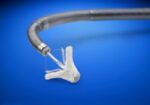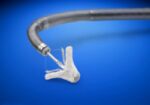Original title: Initial German Experience With Tranapical Implantation of a Second-Generation Trascatheter heart Valve for the Treatment of Aortic Regurgitation. Reference: Moritz Seiffert, et al. JACC Cardiovasc Interv. 2014 Oct;7(10):1168-74. There is a group of patients with severe aortic regurgitation and they are not candidates for surgery; percutaneous implant is an option, but until now, there is little...
Mitra-Clip: a valid alternative for high risk patients
Original title: Percutaneous Mitral Valve Repair for Mitral Regurgitation in High-Risk Patients. Results of the EVEREST II Study. Reference: Donald D. Glower et al. J Am Coll Cardiol 2014;64:172-81 Severe mitral regurgitation (MR) often lead to hospitalization for cardiac failure and heart surgery. Half of these patients are rejected for high surgical risk. Percutaneous intervention is a valid...
Implanting a second valve and embolization are two complications that increase mortality
Original title: Determinats and Outcomes of Acute transcatheter Valve-in Valve Therapy or Embolization. Reference: Raj R Makkar, et al. J Am Coll Cardiol 2013;62:418-30 Percutaneous aortic valve implantation has proven to be feasible, safe and a successful follow up. Only in a few patients is the two-valve implantation necessary due to bad positioning or embolism but...
Valve-in-Valve Implantation Is Possible
Original title: 5 Years Experience With Trancatheter Tranaspical Mitral Valve –in Valve Implantation for Bioprosthetic Valve Dysfunction Reference: Anson Cheung et al. J Am Coll Cardiol 2013;61:1759–66. Percutaneous valves development, first aortic and now mitral, has brought an opportunity to improve life quality and extend life for high risk non-surgical patients. 23 patients received transapical implantation in mitral...
MitraClip® in real life
Original title: Acute outcomes after MitraClip® therapy in highly aged patients: results from the German TRAnscatheter Mitral valve Interventions (TRAMI) Registry. Reference: Wolfgang Schillinger et al. EuroIntervention 2013; 8-online publish-ahead-of-print April 2013. Recently, percutaneous repair of the mitral valve with MitraClip®, (Abbott Vascular, Santa Clara, CA, USA), has emerged as an option for patients with severe mitral regurgitation,...
Mitraclip® year results
Original title: Residual Mitral Valve Regurgitation After Percutaneous Mitral Valve Repair with Mitraclip® System in a Risk Factor of Adverse one-Year Outcome Reference: Liliya Paranskaya et al. Catheterization and Cardiovascular Intervention 81:609-617 (2013). Currently, the gold standard for the treatment of mitral regurgitation (MR) is surgery but 20% of patients are rejected because they present a high surgical...
Favorable outcomes at 5 years post TAVI.
Original title: 5-Year Outcome After Aortic Valve Implantation Reference: Stefan Toggweiler, et al. J Am Coll Cardiol 2013;61:413–9 Percutaneous aortic valve implantation (TAVI) is now a valid strategy as we know its short and medium term evolution but we do not have enough information available about the long term. The aim of this study was to analyze the...
Aortic insufficiency has a poor prognosis in TAVI.
Original title: Impact of Post-Procedural Aortic Regurgitation on Mortality Alter Trancatheter Aortic Valve Implantation Reference: Kentaro Hayashida, et al. J Am Coll Interv 2012;5:1247-56 Transcatheter aortic valve implantation (TAVI) sprung up as a valid strategy to treat patients with severe high risk AS (aortic stenosis). However, residual aortic regurgitation (post AR) and post-dilation remain unsolved. Between October 2006...
Complex angioplasty with ventricular assist
Original title: Real-Word of the Impella 2.5 Circulatory Support System in Complex High-Risk Percutaneous Coronary Intervention: The USpella Registry Reference: Brijeshwar maini, et al. Catheterization and Cardiovscular Intervention For about a decade angioplasty has begun to be performed in increasingly complex patients (PE) such as those with left coronary trunk injury, 3-vessel injury, poor ventricular function and surgically...
Aortic Transfemoral Valve Replacement using Edwards SAPIEN and Edwards SAPIEN XT Prosthesis, Local Anesthesia.
Reference: Durand E. et al (JACC CV interventions 2012 in press)1 When percutaneous aortic valve replacement (AVR) first began the procedure required a large-bore sheath (22-24 F), being the most frequent surgical strategy when using general anesthesia. Continuous technological advances achieved the miniaturization of devices which allow the procedure to be performed with a much...







